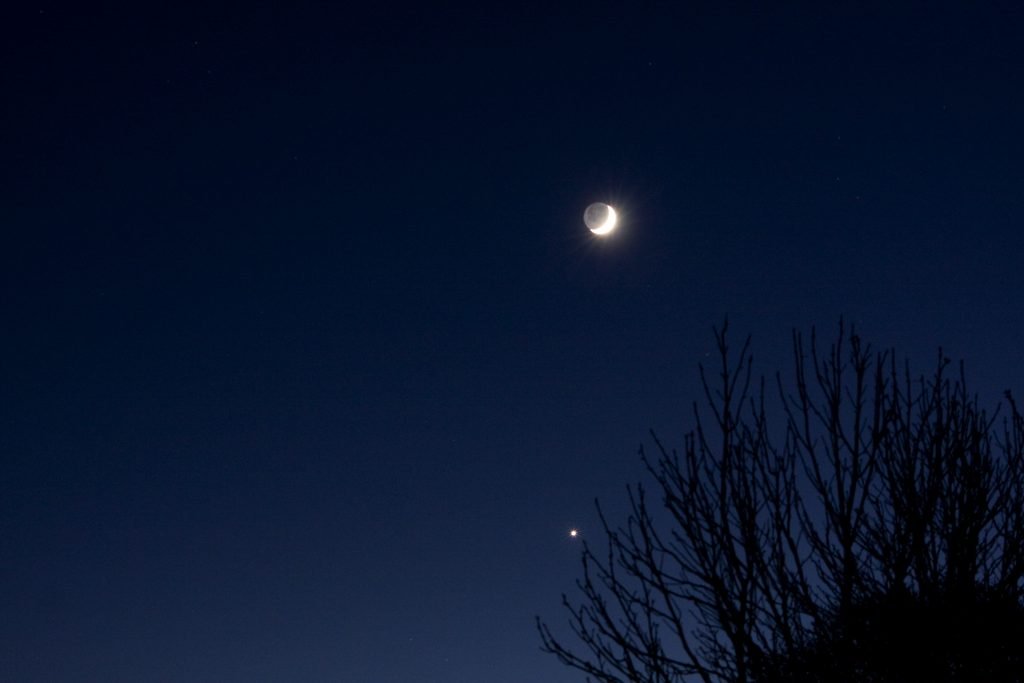Hello once again fellow astrophiles! Well, spring is finally here. So, ladies put on your pink party dress and have your fella grab the moonshine, because it’s time to party under the Pink Moon and earthshine. And there’s shooting stars and a Black Moon too. Why, the excitement is almost unbearable! Ok, Ok, let us calm down a bit and plan our month out nice and smooth like.

First things first. Remember that planetary conjunction I talked about last month with Saturn, Mars and Venus? Well, on the mornings of April 4th and 5th, Mars and Saturn will almost appear to become one planet! That’s how close to each other they’ll be. Of course, if you have a pair of binoculars, you’ll easily be able to distinguish between them, with the two planets switching positions from one night to the other. Look for this fabulous site just before dawn in the southeastern skies.
Next, a beautiful full Pink Moon will be coming up over a mountain near you on April 16.
Next, a beautiful full Pink Moon will be coming up over a mountain near you on April 16. Too bad it won’t actually be pink. Wouldn’t that be awesome? The name actually comes from moss pink, a plant native to this region, which you might find spilling out over the ground like some magical pink blanket this time of year. It would be a cool excursion to just go wander through the woods and see if you can find some.

This full Moon is also sometimes known as the Fish Moon, the Hair Moon, and the Egg Moon, but I think I’m sticking with the Pink Moon. There is one interesting side note though – some people speculate that the Hare Moon/Egg Moon names might possibly be one of the reasons we have the whole Easter Bunny/ Easter Egg thing going on today.
Speaking of Easter, there seems to be a lot of confusion as to what determines the date it occurs on.
Speaking of Easter, there seems to be a lot of confusion as to what determines the date it occurs on. As it turns out, Easter falls on the first Sunday after the Paschal Moon, which is the first full Moon on or after March 21. This can occur any time between March 21 and April 18, meaning that Easter itself can occur on any date between March 22 and April 25. This month’s Pink Moon is this year’s Paschal Moon.
This isn’t really the full story, though, as the actual date of the Paschal Moon is determined by ecclesiastical authorities. In fact, you might be surprised to learn that the Paschal full Moon can occur when there isn’t actually any full Moon at all! The ecclesiastical full Moon does, however, coincide with the astronomical full Moon in most cases. It’s a crazy, mixed up world I’ll tell you.
If you’re waiting for the shooting stars, those will also hit the skies on the night of April 16, when the Lyrids meteor shower arrives in town.
If you’re waiting for the shooting stars, those will also hit the skies on the night of April 16, when the Lyrids meteor shower arrives in town. They’ll stick around through April 25 and will reach their peak on the night of April 22. The Lyrids is considered to be just an average shower, producing about 20 shooting stars per hour at its peak. To see them, go looking any time after 9:30 pm, although later in the night would be better. Note that the waxing gibbous Moon may present somewhat of a challenge to observing the fainter meteors.

The last few nights of the month are a great time to look for earthshine. This occurs when light bounces off the Earth, hits the Moon, and bounces right back to Earth. This causes the otherwise unlit portion of the Moon to be bathed in a ghostly light. To see it, look at the thin waning crescent moon shortly before sunrise. You can also catch it when the waxing crescent Moon appears in the western sky right before sunset in early May. Sometimes you might hear the earthshine referred to as “the old Moon in the new Moon’s arms.” Try looking at it through binoculars for a fantastic view!
Finally, at the very end of the month, that ominous sounding Black Moon will occur.
Finally, at the very end of the month, that ominous sounding Black Moon will occur. But what is it? Surely it portends evil and suffering, right? Actually, it isn’t nearly as ominous as it sounds. A Black Moon is simply the second new moon in a month, an event which occurs on April 30 this year. It’s not even something you can see, as the illuminated half of the Moon is pointed away from Earth in that stage of the monthly Moon cycle. It will be crossing the sky during the day, lost in the overwhelming glare of the sun. But when a Black Moon rises, you can be sure you’ll have black skies that night, which makes for some great stargazing!
Well folks, that about wraps it up for this month. Until next time, remember – always keep an Eye on the Sky!
– HashtagWV #141. April 2022.
-
Barry Pynehttps://hashtagwv.com/author/barry/
-
Barry Pynehttps://hashtagwv.com/author/barry/
-
Barry Pynehttps://hashtagwv.com/author/barry/
-
Barry Pynehttps://hashtagwv.com/author/barry/

